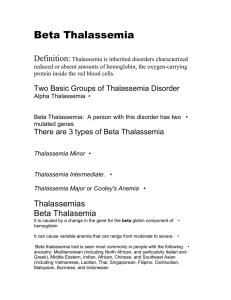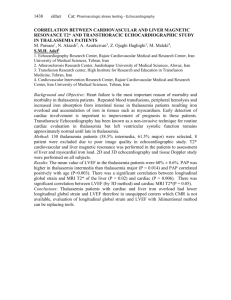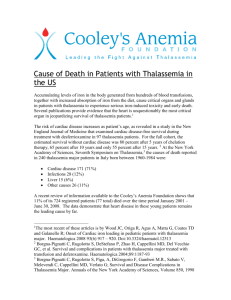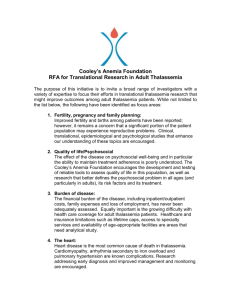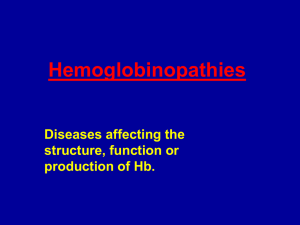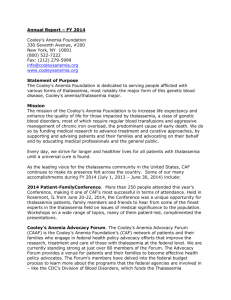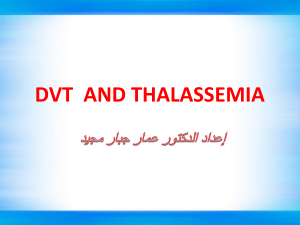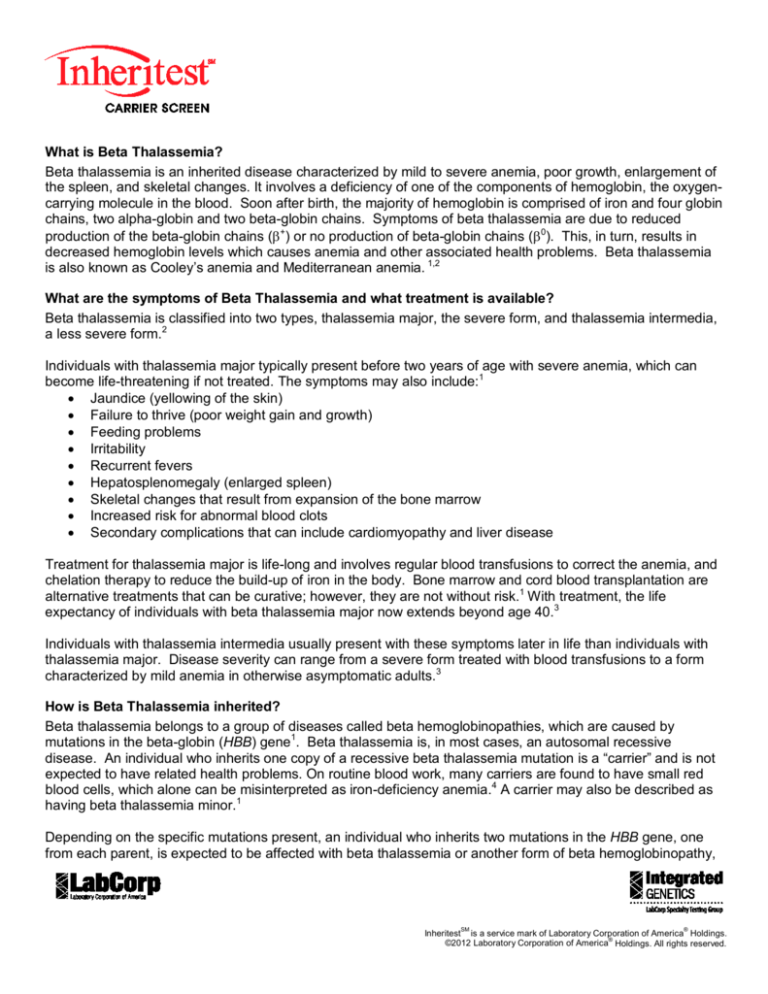
What is Beta Thalassemia?
Beta thalassemia is an inherited disease characterized by mild to severe anemia, poor growth, enlargement of
the spleen, and skeletal changes. It involves a deficiency of one of the components of hemoglobin, the oxygencarrying molecule in the blood. Soon after birth, the majority of hemoglobin is comprised of iron and four globin
chains, two alpha-globin and two beta-globin chains. Symptoms of beta thalassemia are due to reduced
production of the beta-globin chains (β+) or no production of beta-globin chains (β0). This, in turn, results in
decreased hemoglobin levels which causes anemia and other associated health problems. Beta thalassemia
is also known as Cooley’s anemia and Mediterranean anemia. 1,2
What are the symptoms of Beta Thalassemia and what treatment is available?
Beta thalassemia is classified into two types, thalassemia major, the severe form, and thalassemia intermedia,
a less severe form.2
Individuals with thalassemia major typically present before two years of age with severe anemia, which can
become life-threatening if not treated. The symptoms may also include:1
• Jaundice (yellowing of the skin)
• Failure to thrive (poor weight gain and growth)
• Feeding problems
• Irritability
• Recurrent fevers
• Hepatosplenomegaly (enlarged spleen)
• Skeletal changes that result from expansion of the bone marrow
• Increased risk for abnormal blood clots
• Secondary complications that can include cardiomyopathy and liver disease
Treatment for thalassemia major is life-long and involves regular blood transfusions to correct the anemia, and
chelation therapy to reduce the build-up of iron in the body. Bone marrow and cord blood transplantation are
alternative treatments that can be curative; however, they are not without risk.1 With treatment, the life
expectancy of individuals with beta thalassemia major now extends beyond age 40.3
Individuals with thalassemia intermedia usually present with these symptoms later in life than individuals with
thalassemia major. Disease severity can range from a severe form treated with blood transfusions to a form
characterized by mild anemia in otherwise asymptomatic adults.3
How is Beta Thalassemia inherited?
Beta thalassemia belongs to a group of diseases called beta hemoglobinopathies, which are caused by
mutations in the beta-globin (HBB) gene1. Beta thalassemia is, in most cases, an autosomal recessive
disease. An individual who inherits one copy of a recessive beta thalassemia mutation is a “carrier” and is not
expected to have related health problems. On routine blood work, many carriers are found to have small red
blood cells, which alone can be misinterpreted as iron-deficiency anemia.4 A carrier may also be described as
having beta thalassemia minor.1
Depending on the specific mutations present, an individual who inherits two mutations in the HBB gene, one
from each parent, is expected to be affected with beta thalassemia or another form of beta hemoglobinopathy,
SM
®
Inheritest is a service mark of Laboratory Corporation of America Holdings.
®
©2012 Laboratory Corporation of America Holdings. All rights reserved.
including sickle cell disease. Beta hemoglobinopathies exhibit significant variability in severity and age of
onset, which is often related to the specific combination of HBB mutation(s) and the presence of any mutations
in other globin genes1. To date, more than 700 HBB mutations have been described5.
If both members of a couple are carriers of a recessive HBB gene mutation, the risk of having a child who
inherits two HBB mutations is 25% in each pregnancy; therefore, it is especially important that the reproductive
partner of a carrier be offered testing. For the most accurate interpretation, carrier detection may be best
evaluated by combining DNA testing, clinical information, as well as a complete blood count and hemoglobin
electrophoresis.6
Who is at risk for beta thalassemia?
Annually, there are about 42,000 pregnancies affected with beta thalassemia worldwide7. Beta thalassemia
can occur in individuals of all races and ethnicities, but it is more common in some populations, including
individuals of African, Chinese, Mediterranean, Middle Eastern, South Asian, and Southeast Asian ancestry.1
Carrier Rate in Select Ethnic Groups8,9
African American
1 in 75
East Asian
1 in 50
Mediterranean
1 in 20
Middle Eastern
1 in 30
South Asian
1 in 20
Southeast Asian
1 in 30
Having a relative who is a carrier or who is affected can increase an individual’s risk of being a carrier.
Consultation with a genetics health professional may be helpful in determining carrier risk and appropriate
testing.
What does a positive test result mean?
If a gene mutation is identified, an individual should speak to a physician or genetics health professional about
the implications of the result and appropriate testing for the reproductive partner and at-risk family members.
What does a negative test result mean?
A negative result reduces, but does not eliminate, the possibility that an individual carries a gene mutation.
The likelihood of being a carrier is also influenced by family history, medical symptoms, and other relevant test
results.
Where can I get more information?
• Cooley’s Anemia Foundation: http://www.thalassemia.org
• March of Dimes: http://www.marchofdimes.com/baby/birthdefects_sicklecell.html
• Center for Disease Control and Prevention: http://www.cdc.gov/ncbddd/thalassemia/index.html
• Thalassemia International Foundation: http://www.thalassaemia.org.cy
SM
®
Inheritest is a service mark of Laboratory Corporation of America Holdings.
®
©2012 Laboratory Corporation of America Holdings. All rights reserved.
References
1. Cao A, Galanello R. Beta-thalassemia. GeneReviews. Available at:
http://www.ncbi.nlm.nih.gov/books/NBK1426 Accessed Feb 4, 2012
2. Beta-thalassemia. Genetics Home Reference. Available at http://ghr.nlm.nih.gov/condition/betathalassemia. Accessed: Feb 29, 2012
3. Galanello and Origa Orphanet Journal of Rare Diseases 2010, 5:11
http://www.ojrd.com/content/5/1/11
4. About Thalassemia. Cooley’s Anemia Foundation. Available at
http://www.thalassemia.org/index.php?option=com_content&view=article&id=19&Itemid=27. Accessed:
Feb. 29, 2012.
5. Human Gene Mutation Database. Available at https://portal.biobaseinternational.com/hgmd/pro/gene.php?gene=hbb. Accessed Feb 4, 2012
6. Hemoglobinopathies in Pregnancy. ACOG Practice Bulletin, Number 78. January 2007. Obstetrics &
Gynecology 2007; 109(1): 229-237.
7. Modell, B and Darlison, M. Global epidemiology of haemoglobin disorders and derived service
indicators. Bulletin of the World Health Organization. June 2008.
8. Driscoll DA, et al. Prenatal Carrier Screening for Genetic Conditions. NeoReviews. 2004 July; 5: e290e295.
9. Lahiry P, et al. Understanding beta-thalassemia with focus on the Indian subcontinent and the Middle
East. The Open Hematology Journal. 2008; 2: 5-13.
SM
®
Inheritest is a service mark of Laboratory Corporation of America Holdings.
®
©2012 Laboratory Corporation of America Holdings. All rights reserved.

